The dynamic response and damage models of rebar reinforced polymer slabs subjected to contact and near-field explosions
Hao-nan Zhao, Hong-yuan Fang, Xiao-hua Zhao
Yellow River Laboratory, Zhengzhou University, Zhengzhou, 450001, China
Keywords:Reinforced polymer slab Numerical investigations Empirical prediction Damage models
ABSTRACT Non aqueous reactive polymer materials produced by the reaction of isocyanate and polyol have been widely used in infrastructure construction, which may be subjected to explosion loads during complex service conditions.The blast response of composite materials is a crucial aspect for applications in engineering structures potentially subjected to extreme loadings.In this work, damage caused to rebar reinforced polymer slabs by surface explosive charges was studied experimentally and numerically.A total of 6 field tests were carried out to investigate the performances of the failure modes of rebar reinforced polymer slabs under contact and near-field explosions.The influence of explosive quantity(10-40 g)and stand-off distances(0-20 cm)at the damage modes were studied.The results show that the failure modes of rebar reinforced polymer slabs under near-field explosion mainly were bending and surface spalling, while under the impact of contact explosion, the failure modes were craters of the top surface, spalling of the bottom surface, and middle perforation.Furthermore, a detailed fully coupled model was developed and validated with the test data.The influences of explosive quantity and slab thickness on rebar reinforced polymer slabs under contact explosion were studied.Based on this, the calculation formula between breach diameter, explosive quantity, and slab thickness is fitted.
1.Introduction
Since the 21st century,substantial efforts have been undertaken to identify novel technologies to enhance the survivability of structures under extreme loads.Such as polymer, have attracted the attention of researchers due to their feasibility in structural reinforcement.Non-water reacted polymer grouting materials produced from two-component polyurethane foam are a new kind of grouting material [1].Under grouting pressure, the polymer material reacts chemically, expands in volume, and rapidly solidifies [2].This material has high expansibility, early strength, environmental protection[3],good compressive strength[4],relatively high tensile strength[5],and good water impermeability[6].It has been widely used in foundation reinforcement, void filling, antiseepage plugging, and other repair projects [7-10].Because of its lightweight and porous,the polymer is a better energy absorption and energy dissipation material, but its strength is relatively low.Referring to the fact that the strength of concrete can be significantly improved by adding reinforcement [11], whether the addition of rebar reinforcement can improve the explosion resistance of polymer materials needs to be studied urgently.
With the increase in engineering applications, the engineering properties of polymer grouting materials have also received extensive attention.In recent years,many scholars have conducted extensive and in-depth research on the material properties of polymers.Li et al.[12,13] studied the shear modulus, the dynamic viscoelastic properties, and the constitutive model of non-water reacted polyurethane grouting materials.Chen and Wei et al.investigated the flexural strength, compressive strength, stressstrain behavior, microstructure characteristics, fatigue behavior,and failure mode of rigid polyurethane grout materials [14,15].Zhang and Adam et al.studied the fire resistance of polyurethane[16,17].Lin systematically investigated the mechanism of cutting failure in polymers with different densities and evaluated the effects of cutting depth and cutting-edge radius [18].Tjahjanti et al.reconnected the broken polymer-based composites and conducted impact tests to determine impact strength and fracture energy,tensile strength tests, and observed the structure using scanning electron microscopy[19].Liu et al.used the concentric pull-out test to study the effect of polymer density,anchorage length,and rebar diameter on the bond strength between polymer and steel bars[20].These studies focused on static mechanical properties of polymer materials, while there were few studies on dynamic mechanical properties, especially dynamic mechanical properties of rebar reinforced polymer composites.
Field explosion tests and three-dimensional numerical simulations are important means to study the explosion resistance of materials or structures.At present,many scholars have carried out a lot of research on the explosion resistance of reinforced concrete slabs, steel slabs, polymeric composite structures, and other materials[21-25].Li et al.[26]and Ellis et al.[27]studied the influence of explosive charge quantity, blast center distance, and reinforcement ratio on damage features of ultra-high performance concrete through field explosion tests and numerical simulation.A.Gargano et al.[28,29] analyzed the dynamic response of fiber-polymer laminates when loaded by the shock wave generated by an airborne explosive blast.G.S.Langdon et al.[30-32] studied the response of sandwich structures with composite face sheets and polymer foam cores to blast loading.Srikanth et al.[33] used Coupled Eulerian-Lagrangian(CEL)method to investigate the effect of blast load on the column of a multi-storied building, and found that blast damage was mitigated by fitting the column with a layer of energy-absorbing polymeric foam sandwiched with a steel sheet.In the early stage,the damage mode of polymer materials under the action of air and underwater explosions has been explored through field tests.It was found that pure polymer slabs were mainly concentrated broken under explosion impact, and their antiexplosion impact ability was low [34,35].The performance of materials can be improved by adding reinforcement and fiber,so it was an urgent topic to study its damage characteristics under explosion loads.
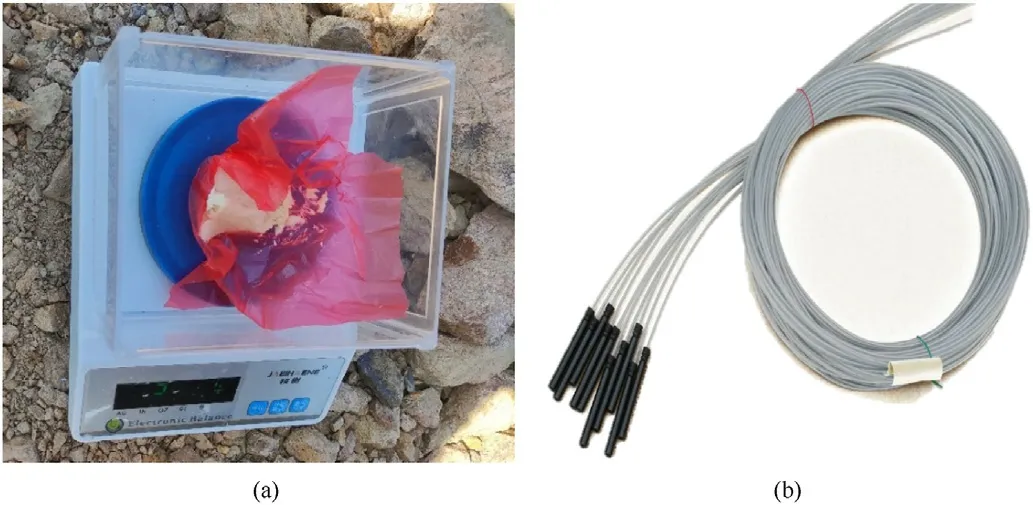
Fig.1.Explosive charges and detonator: (a) Explosive charges; (b) Detonator.
In this study,through field explosion tests,the failure modes of rebar reinforced polymer slabs under contact and near-field explosion impact loads with different explosion quantities were studied.The shock wave data were collected by the shock wave sensor during the tests.The reliability of the model was demonstrated by comparing the numerical simulation results with the field test.On this basis,the dynamic response of reinforced polymer slabs under contact explosion was studied by using the simulation model.The sensitivity of reinforced polymer slab to explosive quantity and slab thickness was explored, and the empirical formulas of slab’s failure diameter, explosive quantity, and slab thickness were put forward, which provides a reference for engineering application and damage evaluation.
2.Field experimental
2.1.Explosive charges and detonator
Rock emulsion explosives with a detonation velocity of 3850 m/s and a material density of 1.05 g/cm3were used in the tests.The rock emulsion explosive was weighed using an electronic balance with a range of 0-300 g and a precision of 0.01 g.As shown in Fig.1(a),during the test,the explosive was wrapped in a thin plastic bag to prevent mass loss of the emulsion explosive during weighing and placing, and ensure the accuracy of test results.An ordinary non-electric detonator was used to detonate the explosive during each test,as shown in Fig.1(b).
2.2.Sample preparation
The two-component foaming polyurethane was primarily composed of polyols (Type WANOL®R2305, Fig.2(a)) and isocyanates (Type WANNATE®CW20, Fig.2(b)).The mixing weight ratio of isocyanate and polyols was designed as 1:1 [36].The strength develops rapidly within 35 s after pouring and stabilizes after 10 min.The polymer material used for making the test piece has a yield stress of 13.71 MPa,a yield strain of 16.9%,a limit strain of 43.8% and a density of 0.2 g/cm3under uniaxial compression.Fig.3 shows the schematic diagram of the manufacturing process,the bound reinforcement was placed in the mould for grouting to obtain a rebar reinforced polymer slab.A total of six rebar reinforced polymer slabs were prepared, and the size of that was 500 × 500 × 60 mm3(Fig.2(c)).The rebar was HRB335 with a diameter of 8 mm, the transverse and longitudinal spacing was 115 mm, arranged in a single layer, and the yield strength was 386.7 MPa.

Fig.2.Raw materials and the schematic diagram of the sample: (a) Materials A; (b) Materials B; (c) The schematic diagram of slab size.

Fig.3.The schematic diagram of the manufacturing process of rebar reinforced polymer slab.
2.3.Experimental setup
Fig.4(a) shows an experimental setup for testing, the steel support was used to provide a fixed boundary.Four shock wave sensors were symmetrically arranged,numbered#1,#2,#3,and#4 from top to bottom,80 cm and 100 cm away from the top of the slab respectively(see Fig.4(b)).Blast-Pro shock wave detector was used to monitor the blast shock wave data.The shock wave sensor was the type of TP-1MP, and its sensitivity coefficient was 5.001,4.961, 5.004, and 4.995 V/MPa, respectively.
2.4.Test program
Six explosion tests in total were carried out in the current study.The sensitivity of rebar reinforced polymer slabs N1-N3 to explosive quantity was studied under near-field explosions.The failure characteristics of rebar reinforced polymer slabs C1-C3 were also tested in the contact explosions.The test program was listed in Table 1.
2.5.Results and discussion
Contact and near-field explosion tests were carried out on six slabs with rebar reinforced polymer slabs to study their damage characteristics under loads of different explosive quantities.
2.5.1.Near-field explosions
In the case of the blast center distance of 20 cm, three kinds of explosive quantities (20, 30, and 40 g) were selected to test the near-field explosions of rebar reinforced polymer slabs N1-N3,respectively.Fig.5 shows the failure mode of the rebar reinforcedpolymer slabs under the near-field explosion load with a distance of 20 cm from the explosion center.

Table 1Test program.
When the slab was impacted by 20 g explosive loading,the top surface of the slab was intact,but there was a through crack on the bottom which was approximately parallel to the fixed end, these damages were believed to be caused owing to stress wave propagation and reflection.With the increase in explosive quantity, the top surface of the slab appeared a spalling failure.When the explosive quantity increased to 40 g, the spalling area of the top surface of the slab accounts for 42% of the total area of the slab,which increased by 1/6 compared with 36% when the explosive quantity was 30 g.In addition, a through-hole with a length of 370 mm and a through-crack were formed in the middle of the slab,the reason was that the compressive stress of the rebar reinforced polymer slab in contact with the explosive exceeds its dynamic compressive strength under the combined action of detonation product and blast wave.Stress wave caused cracks along the two free ends because of the function of fixed boundary.Generated large tensile stresses owing to wave reflection and hence cracking of rebar reinforced polymer slab.The near-field explosion mainly caused spalling damage and crack damage to the slab,and with the increase in explosive quantity, the damage of rebar reinforced polymer slabs became more and more serious.
Fig.6 shows the time history curve of shock wave pressure at each measuring point of rebar reinforced polymer slabs under the action of 20, 30, and 40 g explosive charges in the near-field,respectively.Due to the instrument failure during the test, the data of#2 and#3 measuring points were not measured,only the shock wave data of # 1 and # 4 measuring points were analyzed here.
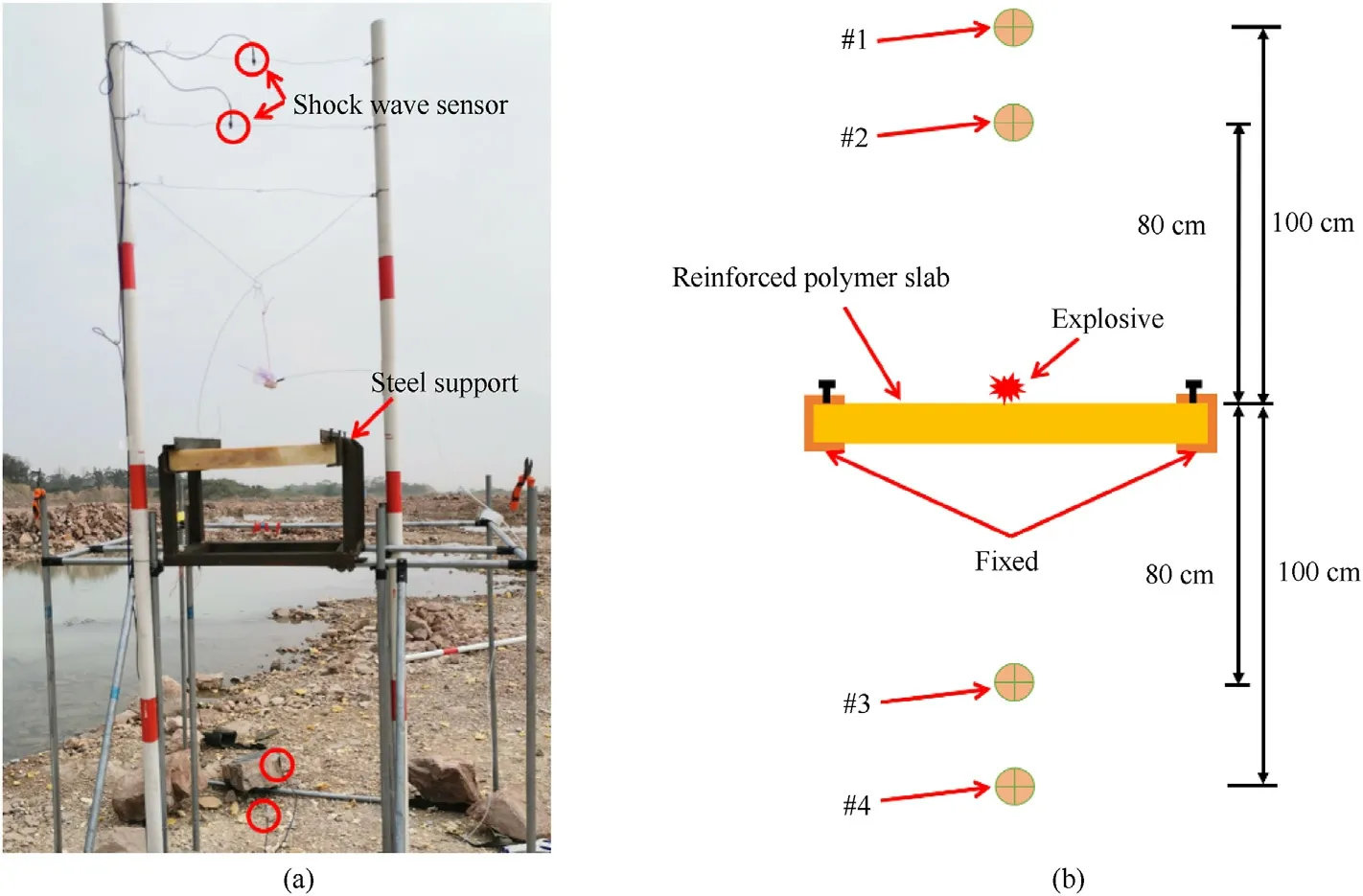
Fig.4.Experimental setup.

Fig.5.Failure mode of rebar reinforced polymer slabs under near-field explosions:(a)20 g; (b) 30 g; (c) 40 g.
When the explosive exploded in the air, a mass of hightemperature and high-pressure gas was formed, which pushed the surrounding static air forward to form a shock wave.The shock wave pressure suddenly jumped from atmospheric pressure to the maximum value,and then quickly decayed to atmospheric pressure and continues to decline,resulting in a negative pressure peak,and finally gradually rose to atmospheric pressure.It could be seen that the overpressure peak pressure of shock wave increases gradually with the increase of explosive quantity,and the overpressure peak value of # 4 measuring point has some degree of attenuation compared with that of # 1 measuring point, the attenuation was 70.22,53.28,and 67.55%respectively.There were two overpressure peaks in the pressure-time history curve of the#1 measuring point above the slab in the near-field explosions, which was due to the reflection of the shock wave after the explosion.
2.5.2.Contact explosions
Fig.7 shows the failure modes of rebar reinforced polymer slabs under the contact explosion of 10,15, and 20 g explosive charges respectively.
In the process of charge explosion,the energy release was very fast and the detonation pressure was very high,which could make the explosive reach the peak pressure instantly and produce impact damage.Firstly, the explosion shock wave propagated in the form of a compression wave.If its peak value was greater than the compressive yield strength of the structure, the explosion crater will appear on the top surface of the structure; When the shock wave reached the bottom surface of the structure, the reflected tensile wave will be generated immediately and propagate in the opposite direction, which will offset the blast wave and form a composite wave.When the peak value of the reflected tensile wave exceeds the compressive wave and the tensile strength of the structure,collapse damage may occur on the bottom surface of the structure.
It could be seen that the damage characteristics of the rebar reinforced polymer slabs in contact explosion were crater damage on the top surface and spalling failure on the bottom surface.Compared with the near-field explosion, the damage of rebar reinforced polymer slabs under contact explosions was more serious.Severe blast load induced perforation failure in the slab and the maximum diameter of the spalling area on the bottom were larger than the crater on the top,nor flexural damage was found at the slab mid-span,and no bending or fracture damage was found in the reinforcement.With the increase in the explosive quantity,the diameter of the crater increased, and the damage to the slab was more serious.
Fig.8 shows the time history curves of shock wave pressure at#1 and # 4 measuring points under the action of contact explosion with different explosive charges.
With the increase of explosive quantity, the peak value of explosion shock wave pressure gradually increases, and the peak value of overpressure at # 1 measuring point above the slab was much larger than that at # 4 measuring point below the slab, # 4 compared with # 1 the peak value of shock wave overpressure attenuated by 90.57, 92.81, and 89.17%, respectively.This indicates that rebar reinforced polymer slabs have good shock wave attenuation performance.Table 2 shows the peak value and attenuation percentage of shock wave overpressure at each measuring point.
Table 2 shows the peak value and attenuation percentage of shock wave overpressure at each measuring point.To more clearly describe the protective ability of reinforced polymer slabs against explosion shock waves, the damage degree of the explosion shock wave to the human body was taken as an example.According to the damaging effect of incident overpressure[37],as shown in Fig.9.In the nearest range where the pressure is approximately 1.373 MPa,the blast wave can inflict fatal injuries to humans resulting in death.A pressure of 0.245 MPa and more can result in the collapse of the lungs whereas,0.098 MPa of pressure can damage the eardrums.If a reinforced polymer protective wall was set 20 cm away from the explosion source (Fig.10(a)), then A will be subjected to the same overpressure as the#1 measuring point,and B will be subjected to the same shock wave pressure as # 4.According to Table 2 and Fig.9,we can clearly understand the shock wave generated by 20 g explosions may cause A rupture of eardrums, while B has only minor injuries due to the existence of a reinforced polymer protective wall;When the explosive increases to 30 g or 40 g,A caused a rupture of eardrums and collapse of lungs whereas,while B only has a rupture of eardrums and lung is no damage.If a reinforced polymer protective wall was set next to the explosion source(Fig.10(b)),the shock wave generated by 10 g or 15 g explosion may cause the rupture of C's eardrums, while D has only slight injuries due to the protection of reinforced polymer wall; When the explosive increased to 20 g,C will be caused a rupture of eardrums and collapse of lungs whereas,while D only has minor injuries.This fully shows that the reinforced polymer has a good attenuation effect on the explosion shock wave,and can be used to weaken the damage of the explosion shock wave to people and buildings.
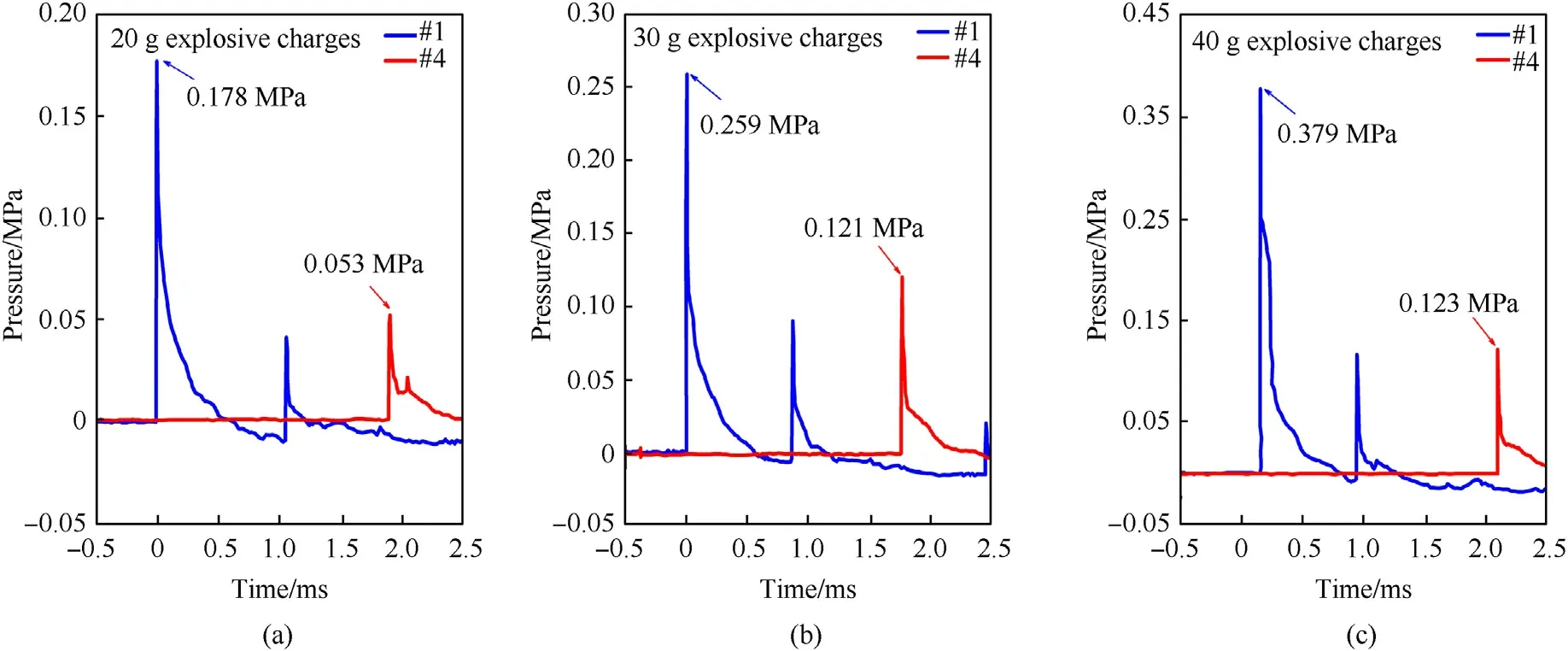
Fig.6.Time history curve of shock wave pressure under near-field explosions.
3.Numerical simulation
In this type of test, it was difficult to discern how the process occurs due to the destructive character of the event and the short duration of the physical phenomenon of both, the blast and the structural response.Moreover, the field explosion test was expensive and dangerous.Therefore, a detailed fully coupled model was developed in the finite element software ANSYS/AUTODYN.Intensive numerical simulations were conducted to explore the influences of explosive quantity and slab thickness on rebar reinforced polymer slabs under contact explosions.
3.1.Material model and its parameters
3.1.1.Air
An ideal gas equation of state(EOS)was used to describe air and was expressed by
where P is the pressure, γ is the constant-pressure to constantvolume specific heat ratio, ρgis the air density, and e0is the specific internal energy.The internal energy of air was used as 2.068×105kJ/kg.This internal energy initialized the air medium to an atmospheric pressure of 101.3 kPa.Table 3 includes the material properties adopted for air.
3.1.2.Rock emulsion explosive
The Jones-Wilkins-Lee (JWL) equation of state was used to describe the explosive material, which is in the form of
where A, B, R1, R2, and ω are empirically derived constants that depend on the type of explosives,V is the volume of charge,and E is the detonation energy per initial unit volume.The material properties used for rock emulsion explosives were tabulated in Table 4.
3.1.3.Polymer
In a previous study [36,38], the stress-strain curve of polymer before yielding is similar to that of concrete,and also through field tests, it is found that the failure mode of polymer materials under explosion load is similar to that of concrete.RHT(Riedel,hiermaier and Thomas)dynamic constitutive model has been widely used in structural explosion impact analysis because it can describe the unrecoverable strain of materials during explosion and reflect the damage evolution characteristics of concrete.The model includes elastic limit surface, failure surface and residual strength surface related to pressure,which can describe the changes in initial yield strength, failure strength and residual strength (Fig.11).We have found that the damage mode of rebar reinforced polymer plate can be well simulated by using RHT constitutive model through many attempts.Therefore, we attempt to use RHT constitutive model to simulate polymer materials,and the EOS is polynomial.The model parameters of polymer materials are given in Table 5.
3.1.4.Rebar
In this study, the rebar is modeled by the John-Cook model,which is suitable for modeling the strength behavior of materials subjected to large strains,high strain rates,and high temperatures.And also this model takes into account the effect of strain rate on material strength.The model defines the yield stress Y as

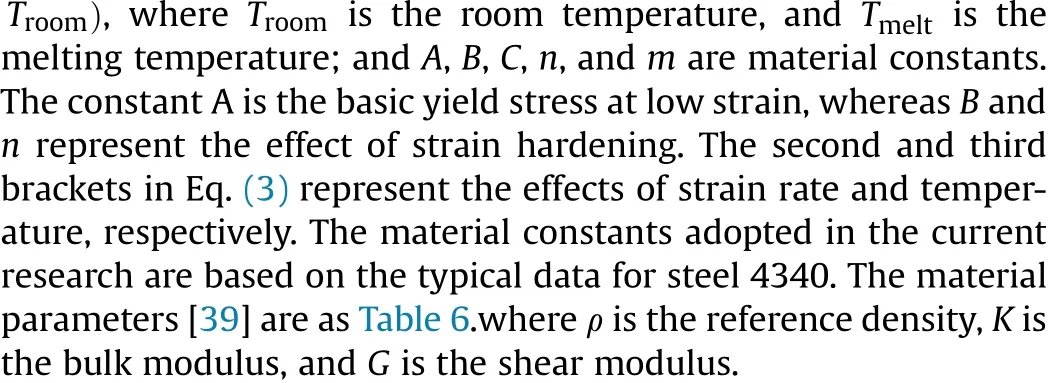
3.2.Verification of contact explosion coupling model
3.2.1.Modelling strategy and geometric model
A numerical model of the contact explosion based on the coupled Lagrangian-Eulerian method was shown in Fig.12,and the reinforced polymer slab model was shown in Fig.13.The dimensions of the air domain were 1.5 × 1.5 × 3.0 m3.The element size of the slab was 5 mm, and the mesh size of the Eulerian elements was about 10 mm.Eight-node hexahedron elements were used to model the polymer and air.Two-node beam elements were used to model the reinforcement bars.The finite element model had a total of 120,000 Lagrangian elements and 675,000 eulerian elements for the plates and air, respectively.
A fully coupled approach combining the Lagrangian and Eulerian algorithms was adopted to simulate the interaction between the structures and fluids.Slabs were modeled by the Lagrangian method, in which the coordinates move with the materials.While the air and explosive charge were modeled by the Eulerian method,in which the mesh was fixed and material flows through it.To reduce the calculation domain and improve the computing efficiency,Flow-out boundaries were applied at outside of the selected Eulerian domain.
3.2.2.Comparison between calculation results and test results
The comparison between simulation results and experimental results under the action of a 20 g explosive contact explosion is shown in Fig.14 and Table 7.
It can be seen from Fig.14 and Table 7 that the established model can better predict the crater and punching perforation failure phenomenon of contact explosion of reinforced polymer slabs,and the numerical simulation is in good agreement with the experimental failure mode.
3.3.Dynamic response process
Under the action of contact explosion load,when the explosion shock wave reaches the reinforced polymer slabs, the material on the top surface is in the state of triaxial compressive stress,which can lead to local damage like a crater.When the other part of the shock wave is transmitted to the rear surface of the reinforced polymer slabs,the material on the bottom surface is in the state of multiaxial tensile stress, which can lead to the spalling and fragment ejection of the polymer, and a through-hole appears in the middle of the slab, no obvious bending and fracture damage was found in the reinforcement.
Fig.15 shows the failure diagram of the rebar reinforced polymer slabs at a different time under the action of 20 g explosives.The legend values 0-1 in the figure represent that the material unit has never been damaged to have complete failure.After the explosion of the charge,under the action of explosion products,compressive stress is generated on the surface of the thin slab,resulting in crater damage on the top surface of the slab,and the tensile stress on the bottom makes the slab spalling fail.With the continuous propagation of stress waves,punching holes are formed in the middle of the slab.
4.Parameter analysis
Based on the validated contact explosion coupled model, the influence of explosive quantities and the thickness of slab on the damage characteristics of rebar polymer reinforced plates under contact explosion conditions were analyzed,and other parameters,boundary conditions,material models and equations of state were unchanged.
4.1.Explosive quantity

Fig.8.Shock wave pressure diagram of rebar reinforced polymer slabs at contact explosions.

Table 2Peak value of overpressure at the measuring point.

Table 3ANSYS/AUTODYN material model for the air.

Table 4The JWL model used to define the rock emulsion explosive material model in ANSYS/AUTODYN.
The numerical models yielded comparable results with the experimental tests and can thus be used in parametric analyses.According to the tests,the explosive mass has been changed based on the verified model, further exploring the sensitivity of rebar reinforced polymer slab to the explosive quantity.Fig.16 shows the damage diagram of 6 cm thick rebar reinforced polymer slabs under contact explosions of different explosive quantities.

Fig.10.Schematic diagram of reinforcement polymer protection.

Fig.11.Space distribution about elastic limit surface, fail surface, residual strength surface, and meridian of RHT constitutive.
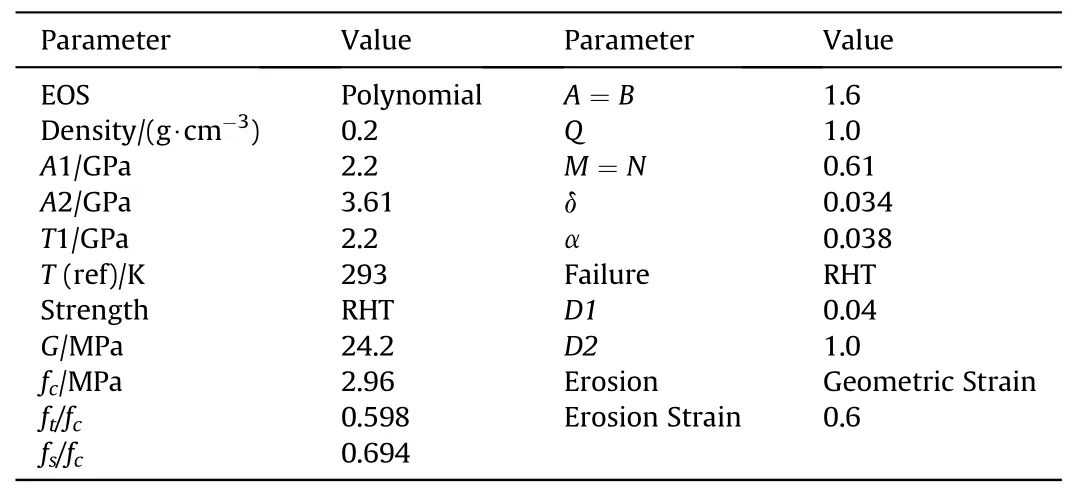
Table 5Parameters of the model for polymer materials.
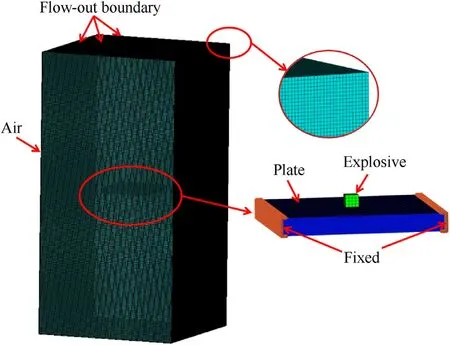
Fig.12.Geometry model of the slab subjected to air contact explosions.

Fig.13.Geometry model of the reinforced polymer slabs.
As can be seen from Fig.16,when the explosive quantity was 1 g,there was a crater on the top surface and spalling damage on the bottom surface of the reinforced polymer slabs, but there was no penetration damage in the middle of the span.When the explosive quantity increases to 2 g, punching perforation damage occurs in the middle of the slab.It is found that the crater diameter on the top surface and spalling diameter on the bottom surface increase with the increase of explosive quantities.
4.2.Thickness of slab
The thickness of the reinforced polymer slabs was 6, 8, and 10 cm,and the other parameters remain unchanged.The explosion response of reinforced polymer slabs with different thicknesses was analyzed.Fig.17 shows the damage characteristics of reinforced polymer slabs with different thicknesses under the contact explosions of 2 g explosive quantities.In order to analyze the failure mode of reinforced polymer slabs under contact explosion more clearly,Fig.18 shows the sectional side view of reinforced polymer slabs with different thicknesses under contact explosion of 2 g explosive quantities.
It can be seen that when the quantity of explosive was 2 g,there were craters of a certain depth on the top surface of the slab with different thicknesses.However,when the thickness of the slab was 10 cm, the bottom surface of the slab had a tensile damaged area,but the backside surface didn’t peel off.The backside was slightly peeled off when the slab thickness was 8 cm.The crater damage and the peeling damage were penetrated, forming through-hole damage when the thickness was 6 cm (Fig.18).
Fig.19 represents the failure modes of rebar reinforced polymer slabs subjected to contact explosion effects.The breach failure mode can further be divided into crater failure,spalling failure,and perforation failure.For rebar reinforced polymer slabs, the reinforcement distributes the impulsive load across the slab, considering the influence of the explosion, the thickness of the slab is small,and the crater will extend below and coalesce with the spall on the distal face to form a perforation failure mode.In order to describe the damage of rebar reinforced polymer slabs more intuitively, the damage depth of the slab under contact explosion is counted as shown in Table 8.The damage depth includes the topcrater depth and bottom spalling depth, as shown in D1and D2in Fig.19.

Table 6ANSYS/AUTODYN material model for the rebar.

Fig.14.Comparison of the numerical and experimental results: (a) Top surface in experimental; (b) Top surface in numerical; (c) Bottom surface in experimental; (d)Bottom surface in numerical.
The ratio K of damage depth to slab thickness is used to evaluate the damage to the slab, which is called the damage coefficient.When K is less than 100%,although the slab is damaged locally,the slab still has a certain bearing capacity;When K reaches 100%,the slab has a through hole.At this time,the slab is completely invalid,loses its bearing capacity, and can’t be used anymore.
5.Failure diameter calculation formula
To accurately predict the failure diameter of reinforced polymer slabs under contact explosions, based on the explosive quantity,slab thickness, and failure diameter data were obtained from parameter analysis.The empirical formula for failure diameter of reinforced polymer slabs was obtained through multiple nonlinear regression analyses.The fitting curve was given,and the damage of reinforced polymer slabs under different explosive quantities and slab thickness can be judged by curves and formulas.Based on the numerical analysis results,the calculation formula between the top surface breach diameter d,explosive quantity w,and slab thickness t is fitted.
The calculation formula of top surface failure diameter is
Similarly, the calculation formula of bottom surface failure diameter is
where d1is the top surface failure diameter(mm),d2is the bottomsurface failure diameter(mm),w is the weight of explosive(g),and t is the thickness of the slab (cm).

Table 7Comparison of the numerical and experimental results of 20 g explosive quantities.

Fig.15.Damage diagram of the thin slab at different times under 20 g explosives.
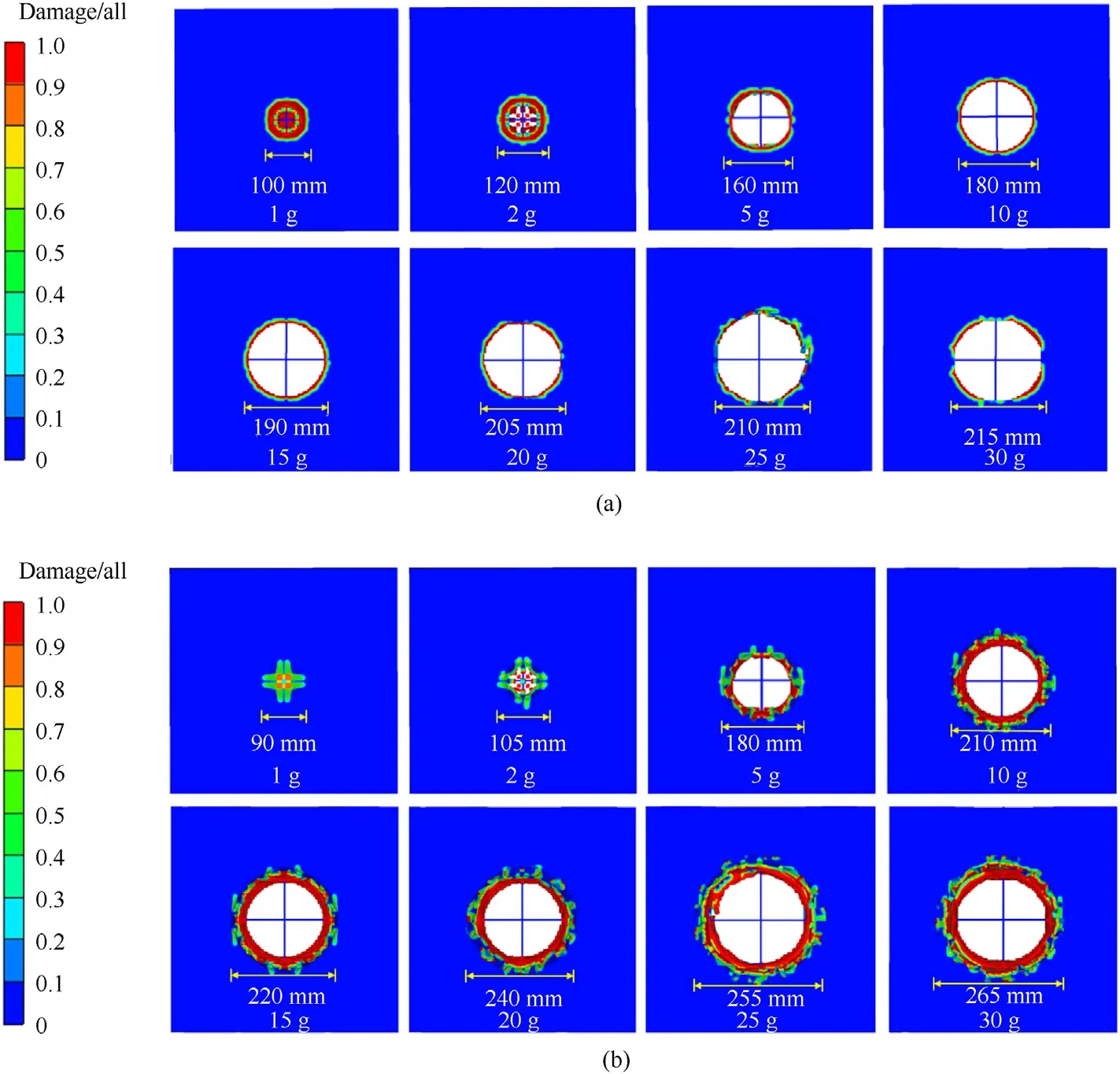
Fig.16.Numerical simulation failure diagram of 6 cm thick reinforced polymer slabs under different explosive quantities: (a) Top surface; (b) Bottom surface.
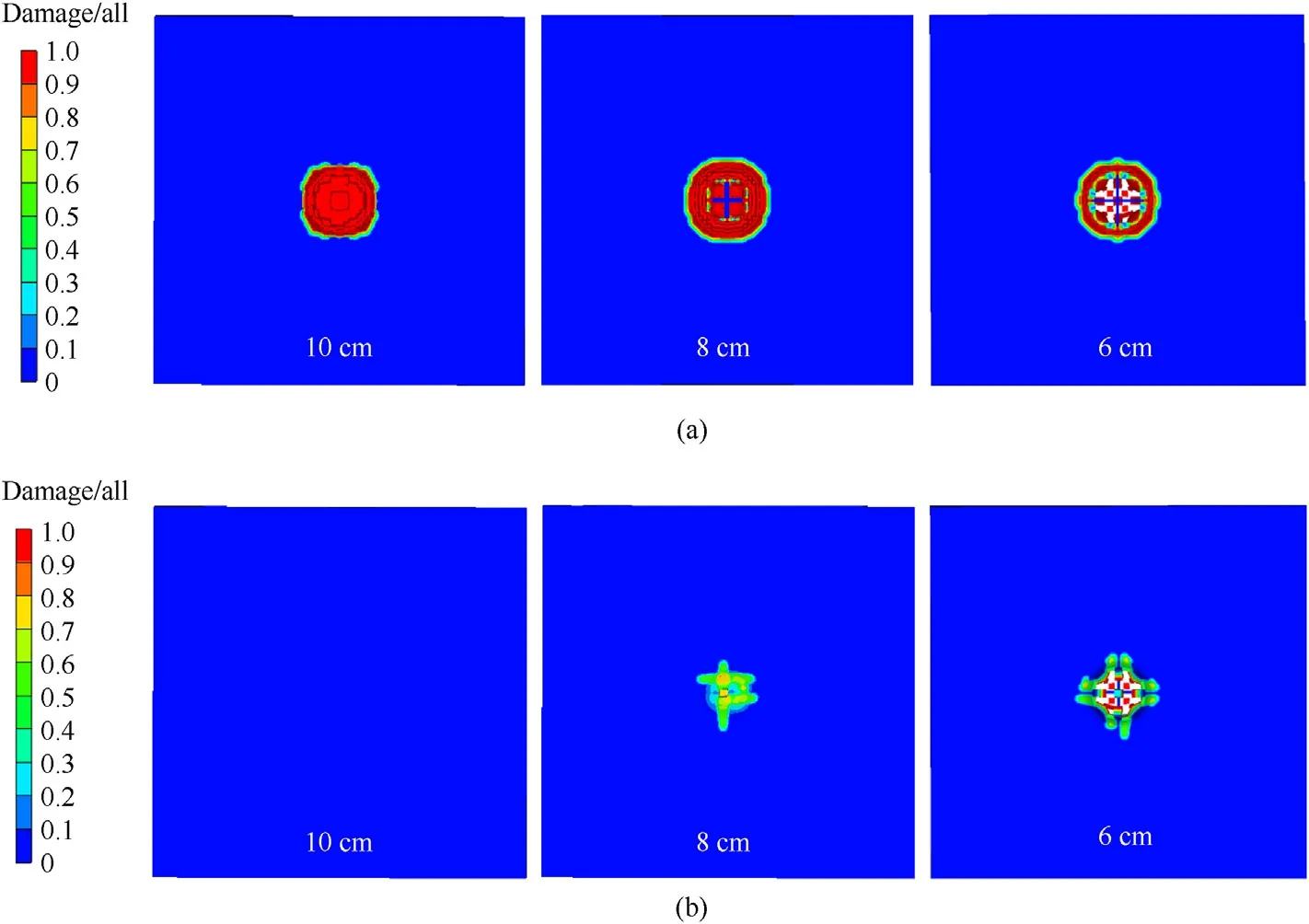
Fig.17.Failure diagram of reinforced polymer slabs with different thicknesses under contact explosions of 2 g explosive quantities: (a) Top surface; (b) Bottom surface.
Fig.20 is a three-dimensional curved surface diagram of the top surface and bottom surface failure diameter, explosive quantity,and slab thickness of reinforced polymer slabs respectively,and the red dots in the figure represent the numerical analysis results.The variances of the fitting results were 0.937 and 0.947, respectively.The fitting accuracy was within the allowable range,which showed that the fitting formula can better predict the failure diameter of rebar reinforced polymer slabs.

Fig.18.Sectional side view of reinforced polymer slabs with different thicknesses.

Fig.19.Failure mode of rebar reinforced polymer slabs under contact explosions.
Table 9 shows the error analysis of fitting results of the empirical formula for reinforced polymer slabs.It can be seen from Table 9 that the error between the fitting formula results and thenumerical analysis results is small, and the error is no more than 9%, indicating that the failure diameter calculation formula is very close to the numerical calculation results,and the formula can well fit the correlation between the failure diameter of reinforced polymer slabs, explosive quantity, and slab thickness.Therefore,the calculation formula of multi-parameter breach diameter can effectively predict the failure diameter of reinforced polymer slabs under contact explosions.
6.Conclusions
Explosion experiments were carried out on six rebar reinforced polymer slabs with the size of 50 cm×50 cm×6 cm.The measured time-history data of blast shock waves were analyzed.Then, the accuracy and reliability of the numerical model were validated by comparing damage models with field test results.Based on this,the sensitivity of slabs to explosive quantity and the thickness of the slab were analyzed.The following conclusions can be drawn from the results:
(1) The failure modes of rebar reinforced polymer slabs under near-field explosions are mainly bending and surface spalling.When the explosive quantity is large,perforation failure occurs in the center of the slab.
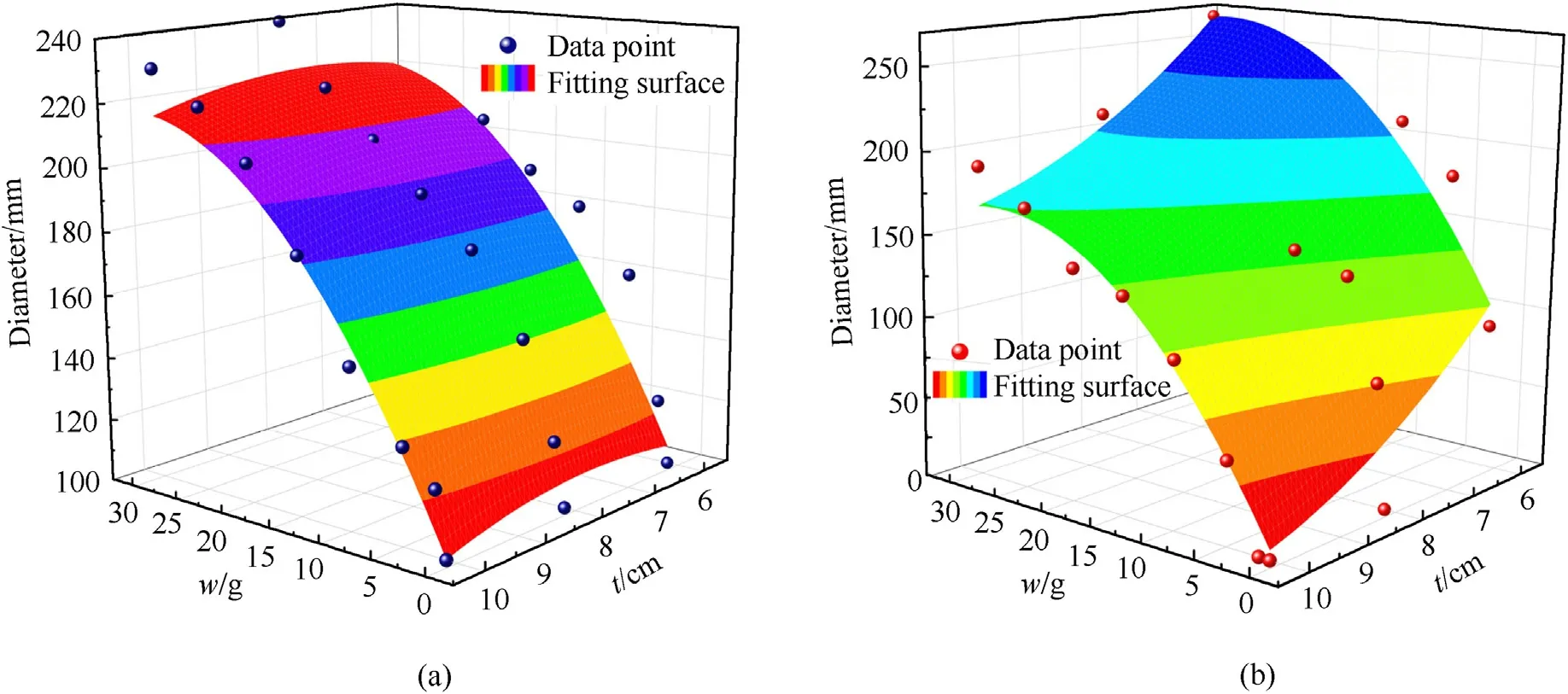
Fig.20.Failure diameter relation of reinforced polymer slabs: (a) Top surface; (b) Bottom surface.

Table 9Fitting results of empirical formula for breach diameter of the slab.
(2) Under the contact explosions,rebar reinforced polymer slabs mainly suffered crater damage on the top surface, spalling damage on the bottom surface, and penetration damage on the center.The damage to the slab is further evaluated by the defined damage coefficient K.
(3) The rebar reinforced polymer slab has a good attenuation effect on explosion shock waves based on the obtained shock wave pressure time history curve from the tests.
(4) The calculation formula between the breach diameter,explosive quantity, and slab thickness is fitted based on a large number of simulation calculations.The formula can accurately predict the damage diameter of rebar reinforced polymer slabs, which can provide a reference for future research and engineering application.
Data availability statement
All the data are included within the article in tables and figures.
Declaration of competing interest
The authors declare that they have no known competing financial interests or personal relationships that could have appeared to influence the work reported in this paper.
Acknowledgements
This work was supported by the National Natural Science Foundation of China(Grant Nos.52009126,51939008),Foundation of Hubei Key Laboratory of Blasting Engineering(Grant No.BL2021-04), First-class Project Special Funding of Yellow River Laboratory(No.YRL22IR08).
- Defence Technology的其它文章
- Eigen value analysis of composite hollow shafts using modified EMBT formulation considering the shear deformation along the thickness direction
- Synthesis of energetic coordination polymers based on 4-nitropyrazole by solid-melt crystallization in non-ionization condition
- RDX crystals with high sphericity prepared by resonance acoustic mixing assisted solvent etching technology
- Study of residual stresses and distortions from the Ti6Al4V based thinwalled geometries built using LPBF process
- Modeling and simulation of solvent behavior and temperature distribution within long stick propellants with large web thickness undergoing drying
- Assessment of the ballistic response of honeycomb sandwich structures subjected to offset and normal impact

